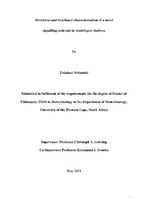| dc.description.abstract | Nitric Oxide (NO) influences a wide range of physiological processes in plants including growth and development, responses to abiotic and biotic stress and pathogen responses. NO binds to the heme group of the mammalian soluble guanylyl cyclase, which activates the enzyme to convert guanosine 5’ triphosphate (GTP) to a second messenger guanosine 3’, 5’ cyclic monophosphate (cGMP). Cyclic GMP further activates other signalling cascades including the regulation of protein kinases, ion gated channels and phosphodiesterases. In plants, a few GCs have been identified and these include AtGC1, AtBRI1, AtWAKL10, and AtPSKR1, however, a GC that contains a heme binding motif that senses NO has yet to be
identified. In order to identify such molecules, a search motif based on conserved HNOX domains and the conserved and functionally assigned amino acid residues in the catalytic centres of annotated GCs was designed and used to search the Arabidopsis thaliana proteome. Several candidate molecules were identified including a flavin-containing monooxygenase (FMO)-like protein and the At5g57690 which is currently annotated as a diacylglycerol kinase. FMOs found in bacteria, yeast, and animals are the most important monooxygenases since they are involved in xenobiotic metabolism and variability in drug response. FMOs in plants are implicated in catalysing specific steps in auxin biosynthesis,metabolism of glucosinolates and pathogen defense mechanisms. The human diacylglycerol
kinase acts as a lipid kinase that mediates a wide range of biological processes which include cell proliferation, differentiation and turmogenesis. In prokaryotes, the structure of Escherichia coli lipid kinase has been solved however, its function has not yet been demonstrated. So far, the occurrence of the diacylglycerol kinases in plants has not yet been reported, and their structure and function also remain elusive. The domain architecture of the 2 molecules (AtNOGC1 and At5g57690) identified by the HNOX-based search strategy revealed that these molecules contain a GC and a heme-binding motif that is conserved among all known heme-binding proteins.In this study, the role of AtNOGC1, a novel NO binding protein in higher plants was investigated and the results showed that this molecule contains an NO-dependant active GC domain. The sequence was first analysed and the location of the HNOX and the GC motifs highlighted. The protein was then recombinatly expressed as a His-SUMO fusion protein and the purification optimised by a second step of ion exchange chromatography. Electrochemical
techniques such as cyclic voltammetry and square wave voltammetry were used to
demonstrate the binding of NO and O2 to the AtNOGC1. Electrochemical data revealed that AtNOGC1 has a lower affinity for O2 and a higher affinity for NO, an important signalling molecule in plants.The presence of the GC activity in AtNOGC1 was investigated by conducting GC activity assays in vitro in the presence or absence of NO. The GC activity assays demonstrated that AtNOGC1 can synthesize cGMP from GTP in vitro. It was also noted that NO was required for the maximum activation of AtNOGC1 catalytic activity. NO-activated catalysis resulted in a >2 fold excess of cGMP production compared to an NO-independent GC activity assay.
The effect of calcium in regulating the GC activity was also investigated and an increase in cGMP levels was observed however, this was just a preliminary finding that requires further experimentation.3 Homology models for both the FMO-like (AtNOGC1) and the diacylglycerol kinase(At5g57690) were built using Modeller program, and important amino acid residues underlying the heme-binding and GC motifs were identified. Residues corresponding to the motifs, which give signature to AtNOGC1 as an FMO, were also noted. In addition,computational functional prediction also suggested the role of AtNOGC1 in a number of processes which include ion binding and functioning as an FMO.Taken together, these findings suggest that AtNOGC1 is a novel Arabidopsis thaliana hemebinding protein that senses NO with higher affinity than for O2. Though AtNOGC1 is currently annotated as a FMO-like protein, it contains a NO-sensitive GC activity and shares limited sequence similarities with mammalian sGC and the recently identified HNOX
domains. Homology modelling strongly suggests that AtNOGC1 and At5g57690 belong to the families of FMOs and diacylglycerol kinases respectively. The domain organisation of AtNOGC1 suggests that more of its functions still remain to be identified. The cloning and characterisation of the At5g57690 gene will provide possible means for further experimentation as well as affording more insights into the exact functions of lipid kinases in plants. | en_US |

